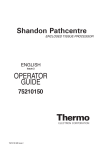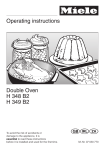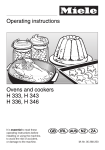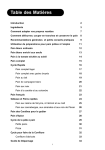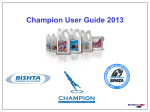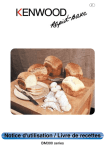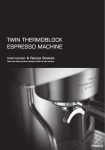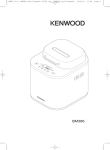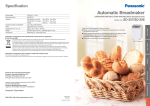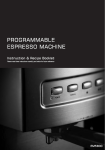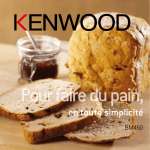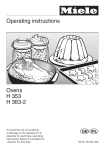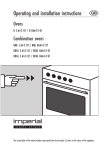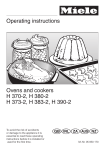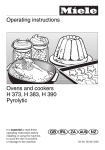Download Direct power BM210J Troubleshooting guide
Transcript
Instructions/Recipe Book BM200 series “QUICK START GUIDE” GETTING STARTED WITH YOUR BREADMAKER Before using your breadmaker for the first time read the instructions and recipe book supplied carefully. To familiarise yourself with the breadmaker we suggest you try either of the following recipes as your first bread loaf. Recipe Setting/Ingredients Water Unbleached white bread flour Skimmed milk powder Salt Large White Loaf 2 300mls (101⁄2 fl oz) Rapid White Loaf 12 300mls (101⁄2 fl oz) (warm 30-35°C 450g (1lb) 450g (1lb) 20mls (4tsp) 20mls (4tsp) 7.5mls (11⁄2tsp) 5mls (1tsp) Sugar 15mls (3tsp) 15mls (3tsp) Butter 25g (1oz) 25g (1oz) 10mls (2tsp) 15mls (3tsp) Easy blend dried yeast Method 1. Remove the bread pan from the 2. 3. 4. 5. 1. Remove the bread pan from the machine and fit the kneader. machine and fit the kneader. Add the ingredient to the pan in 2. The water must be lukewarm (3035°C) or the bread will not rise. the order shown in the above Measure with either a chart. thermometer or mix 70mls boiling Insert the bread pan into the water with 230mls cold water. oven chamber using the alignment mark (▲), ensuring the 3. Add the ingredient to the pan in the order shown in the above chart. pan clicks down and is facing the 4. Insert the bread pan into the right way. Close the lid. oven chamber using the Plug in and press the SELECT alignment mark (▲), ensuring the button until (2) appears in the pan clicks down and is facing the display. right way. Close the lid. Press the START button. 5. Plug in and press the SELECT button until (12) appears in the display. 6. Press the START button. HINTS & TIPS FOR SUCCESSFUL LOAVES 1. Always follow the recipes supplied and ensure that all the ingredients are measured and weighed accurately. Always use level spoon measurements. The measuring cup supplied should only be used to measure liquid ingredients. Inaccurate measures will produce poor results. 2. Always use fresh ingredients and check the date codes have not expired especially on the yeast and flour. Once a sachet of yeast is opened it must be used within 48 hours. Opened sachets can be resealed and stored in the freezer until required. 3. The amount of water required may vary slightly depending on the type and brand of flour used and minor adjustments may be required when a particular brand is first used. If the bread does not rise enough and is dense in texture, try increasing the water next time by 15mls (3tsps). Note: The rapid bake setting will produce a softer crust and a slightly smaller denser loaf than the other setting due to the shorter proving cycle. 4. For best results and to retrain a crusty texture remove the loaf from the breadmaker as soon as the baking cycle ends. The crust will soften if left on the warming cycle. 5. The wholewheat programs (4), (5), (6) begin with a 15-30 minute rest period. During this time the kneader will not move. FOR ADDITIONAL INFORMATION REFER TO THE TROUBLESHOOTING GUIDE AT THE BACK OF THE INSTRUCTION BOOK Contents Introduction 1 Important Safeguards 2 Your Kenwood Breadmaker 3 The Control Panel 4 How to Use Your Breadmaker 5 The Select pad 6-7 The Timer pads 8 Breakdown of Bread/Dough Cycle Times 9 Care & Cleaning Recipes & Ingredients 10 11 - 47 Adapting Your Own Recipes 16 Removing, Slicing & Storing Bread 17 General Hints and Tips 18 - 19 Rapid Cycle 20 - 22 Basic White 23 - 27 Wholemeal 28 - 31 French 32 Sweet Breads 33 - 36 Cakes & Quick Breads 37 - 40 Dough Cycles 41 - 45 Jam Making Cycle 46 - 47 Troubleshooting Guide 48 - 50 Service & Customer Care 51 3 Introduction Bread plays an important role in our diet, providing essential vitamins, minerals and protein. Whole wheat breads made with wholemeal flour and multi-grain loaves are also a good source of fibre. Your bread maker will help you transform a few ingredients into a tasty golden loaf of bread, taking away all the hard work of mixing and kneading as well as lots of washing up. If like most people you want to get straight into make your first loaf of bread with your new machine, then try the recipes in the quick start guide at the front of the book. Get to know your machine, and do not be disappointed if your first attempts look a little less than perfect, they are still sure to taste wonderful. After you have made a few loaves following the recipes in this booklet you may wish to experiment for yourself to find out how to achieve even better results. Here you will find information on the basic ingredients which will help you understand the importance of them for successful bread making. There are hints and tips to help ensure the best results, plus how to adapt your own recipes for use in the bread machine. 1 OPERATING INSTRUCTIONS For your safety and that of those around you, please take special care to read the Important Safeguards listed here: IMPORTANT SAFEGUARDS 1 Read all the instructions – it will enable you to make maximum use of your Bread Maker. 2 DO NOT touch hot surfaces. Accessible surfaces are liable to get hot during use. Always use oven gloves to remove the hot bread pan. 3 To prevent spillages inside the oven chamber, always remove the bread pan from the machine before adding the ingredients. Ingredients that splash onto the heating element can burn and cause smoke. 4 Only use your Bread Maker for it’s intended domestic use. 5 DO NOT use this appliance if there is any visible sign of damage to the supply cord or if it has been accidentally dropped. 6 DO NOT immerse this appliance, the supply cord or the plug in water or any other liquid. 7 ALWAYS unplug this appliance when not in use, before fitting or removing parts or before cleaning. 8 DO NOT let the electrical supply cord hang over the edge of a work surface or allow it to touch hot surfaces such as a gas or electric hob. 9 Close supervision is necessary when the appliance is being used by or near children or infirm persons. 10 DO NOT place your hand inside the oven chamber after the bread pan has been removed. 11 DO NOT touch moving parts within the Bread Maker. 12 DO NOT exceed the maximum capacities stated as this could result in overloading the Bread Maker. 13 DO NOT place the Bread Maker in direct sun light, near hot appliances or in a draught. All these things can affect the internal temperature of the oven, which could spoil the results. 14 In the unfortunate event of a power cut occurring after the ingredients have been partly processed, you will have to start from scratch. 15 DO NOT use this appliance outdoors. 16 DO NOT operate the Bread Maker when it is empty as this could cause it serious damage. 17 DO NOT use the oven chamber for any type of storage. 18 DO NOT cover the steam vents in the lid and ensure there is adequate ventilation around the bread maker during operation. 19 Clean the oven and pan thoroughly after use but only after they have cooled. 20 DO NOT let children play with this machine. 2 YOUR KENWOOD BREADMAKER 1 1. Oven Lid Handle 2. Viewing Window 3. Locking Clip 4. Control Panel 2 5. Alignment Marks 6. Locking Clip Location 3 7. Heater Element 8. Bread Pan Handle 4 9. Kneader 10. Drive Shaft 11. Drive Coupling Measuring Cup Measuring Spoon Bread Pan 8 Oven Inside – Top View 6 9 5 10 7 11 3 5 THE CONTROL PANEL On/Off switch Display Window Timer Set Pads TIMER SET WHITE Program Select Pad SELECT 0 1 2 3 Extended Bake Regular Large Large Dark WHOLEWHEAT Start Pad START 4 Regular 5 Large 6 Large Rapid SPECIALITY Stop Pad STOP 7 8 9 10 11 12 French Sweet Dough Cake/Quick Bread Jam Rapid Cycle 4 Guide for selecting the cooking program HOW TO USE YOUR BREAD MAKER Before plugging in: ● Make sure your electricity supply is the same as the one shown on the underside of your Bread Maker. ● IMPORTANT: UK only – The wires in the cord are coloured as follows: Green & Yellow = Earth • Blue = Neutral • Brown = Live ● This machine complies with European Economic Community Directive 89/336/EEC Before using your bread maker for the first time: ● Remove all packaging and any labels including the cardboard support under the pan. ● Wash all parts (see cleaning). Your BM200 Breadmaker is fitted with an ON/OFF switch and will not operate until the “ON” switch is pressed. ● Plug in the Breadmaker and switch on – SEL will flash on the display panel. ● Then follow the operating instructions in your instruction/recipe book supplied. ● Always switch off and unplug your breadmaker after use. How to measure ingredients: It is extremely important to use the exact measure of ingredients for best results. Do not mix metric and imperial measurements. Use one only. ● ALWAYS measure liquid ingredients in the see-through measuring cup with graduated markings provided. Liquid should just reach marking on cup at eye level, not above or below. ● ALWAYS use liquids at room temperature, 20ºC / 68ºF, unless making bread using the rapid 1 hour cycle. Follow the instructions given in the recipe section. ● ALWAYS use the measuring spoon provided to measure smaller quantities of dry and liquid ingredients. For 1 tsp, fill to the top and level off the spoon. For 1/2 tsp measure up to the line. 5 THE SELECT PAD The SELECT pad lets you choose from a number of different bread settings as well as a dough and jam setting. With each press of the SELECT pad, the number in the display panel will advance to the next setting in the control panel menu. You might for example, want to bake a large dark loaf in which case you would press the key pad until ‘3’ appeared on the display panel, followed by the START pad. When you first plug the Bread Maker to the electricity supply a single bleep will sound and SEL (short for Select), will flash indicating that you should select the setting you want. You have 12 choices. WHITE WHOLE WHEAT SPECIALITY 0 Extended bake 4 Regular 7 French 1 Regular 5 Large 8 Sweet 2 Large 6 Large Rapid 9 Dough 3 Large dark 10 Cake/Quick Bread 11 Jam 12 Rapid Cycle 0 The Extended Bake setting allows you to lengthen the baking time after completion of a cycle. After inspection you may want to bake your loaf a bit longer to get it just how you want it. The extended bake can only be used after completion of one of the bread cycles and after ‘END’ appears in the display. To activate extended bake: ● Press the STOP pad (keep your finger on it) and SEL will appear on the display. STOP = SELECT = ● Press the SELECT pad and choose the ‘O’ setting. ● Press the TIMER SET pads until the desired extended bake time is shown. The display automatically defaults to ‘0:20’ but you can select from 1 minute to 60 minutes. ● Press the START pad and the display colon (:) will flash to show the countdown has begun. If you make a mistake or wish to change the bake time during the count down, press the stop pad until it bleeps and SEL is displayed. You can then reset the time. ● At the end of the extended bake cycle, it will bleep and SEL will be displayed. At this stage you cannot reset the extended bake again. 6 = START = THE SELECT PAD 1 2 3 The White settings can be used for almost any bread recipe using white bread flour as the main flour. 4 5 6 Whole wheat settings should be used for bread recipes using whole wheat or wholemeal bread flour as the main flour. 4 5 7 The French setting provides a crisp crust due to the longer baking time. 4 5 8 The Sweet setting bakes bread at a lower temperature to minimize overbrowning of doughs that contain more sugar. 4 5 9 The Dough setting is used when you wish to make dough for hand shaping and baking in your own oven. 4 5 10 The Cake/Quick Bread setting is unique as it makes non-yeast, cake-like batter breads such as ginger bread. Quick breads do not require any rising times. The ingredients are simply mixed and the bread is baked. 4 5 11 The Jam setting automatically cooks jam in the bread pan. 4 5 12 The Rapid Cycle can be used to make a loaf of hot, fresh bread in just one hour. For best results, extra easy blend yeast and less salt must be used. Please note: When using the basic white large (2-3) and sweet (8) settings, an alert will sound during the last 5 minutes of the second knead cycle as a reminder to add ingredients if required. If you are not adding ingredients, simply ignore the alert. When using programs (1–8, 10, 12) the Bread Maker will automatically go into the Keep warm mode at the end of the baking cycle. It will stay on the keep warm mode for up to one hour or until the machine is turned off, which ever is soonest. If using eggs, milk or other ingredients from the fridge, leave at room temperature for 30 minutes before using. 7 THE TIMER SET PADS The TIMER SET pad allows you to delay the bread making process up to 12 hours beyond the time of the setting selected. The delayed start is not recommended for use with dough, jam or rapid bake settings. IMPORTANT: When using this delayed start function you must not use perishable ingredients – things that ‘go off’ easily at room temperature or above, such as milk, eggs, cheese and yogurt etc. To use the TIMER SET simply place the ingredients in the bread pan and lock the pan into the bread maker. Then: ● Press SELECT to choose the required setting. ● Press the timer pad and the cycle time for the selected setting will be shown. Keep pressing the timer pad until the total time required is displayed. The timer pads when pressed, move in 10 minute increments. You do not need to work out the difference between the setting time selected and the total hours required as the bread maker will automatically include the setting cycle time when the timer pad is first pressed. ● If you go past the desired time, press the timer pad to return. Example: Finished loaf required at 7am. If the breadmaker is set up with the required recipe ingredients at 10pm the evening before, total time to be set on the delayed timer is 9 hours. ● Press select to choose your setting e.g. (3) and use the timer pad to scroll the time in 10 minute increments to display ‘9:00’. If you go past ‘9:00’, simply press the timer pad until you return to ‘9:00’. ● Press the start pad and the display colon (:) will flash to show the timer has been set and the minutes will start to count down. ● If you make a mistake or wish to change the time set, press the STOP pad until it bleeps and SEL is displayed. You can then reset the time. = START = STOP = ● When the cycle is complete END will show on the display and it will bleep to let you know the bread is baked. Important note: Always switch off the electricity to the Bread Maker after use and remember to use oven gloves when removing bread from the bread pan. Always clean the bread pan with a warm damp cloth and dry thoroughly after use. 8 BREAKDOWN OF BREAD/DOUGH CYCLES So you know exactly what is going on inside the Bread Maker during the process time, the following chart breaks down the time in minutes and seconds that each cycle requires. These times are approximate and should be used as a guide only. The total process time is also given in hours and minutes, depending on the selection made. SETTING CYCLE 0 1 2 EXTEND BASIC BASIC BAKE REG. LARGE 700g/ 900g/ 11/2 LB 2LB 3 4 5 6 7 8 9 10 BASIC WHOLE WHOLE WHOLE FRENCH SWEET DOUGH QUICK LARGE WHEAT WHEAT WHEAT BREAD DARK REG. LARGE LARGE 900g/ 700g/ 900g/ RAPID 2LB 11/2 LB 2LB 900g/ 2LB 12 ONE HOUR BREAD CYCLE Rest* - - - - Knead 1 - 6min 6min 6min Knead 2 - 27min 31min** 31min** 18min 25min 25min 22min 31min** 24min 14min 15min 11min Rise 1 - 23min 29min 29min 120min 120min 39min 34min 40min 60min Punch 1 - - - - - - 15sec Punch 2 - - - - - - Punch 3 - - - - - - Rest - - - - - - Shape 1 - 5sec 5sec 5sec - - 3sec Shape 2 - 10sec 10sec 10sec - - Shape 3 - 5sec 5sec - - - 64min 54min 54min - - Rise 2 Bake 5sec 30min* 30min* 15min* 11 JAM 6min 6min 6min - - - - - - 6min 6min 6min 6min 45min - 5sec - - 17min 5sec - - - - - 10sec 10sec - - - - - 5sec 5sec - - - - 15min 29min 29min - - - - 5sec - - - - - 10sec 10sec - - - - - 5sec - - - - 5sec 5sec 45min 54min 49min - - - - 60min 45min 50min 70min 50min 55min 55min 65min 50min - 90min - 31min - 60min - 60min 1:30 1:50 1:00 0:59 Keep Warm - Total Time*** 1:00 Max Time Delay - 60min 60min 60min 60min 60min 60min 60min 60min 2:45 2:50 14:45 14:50 3:10 3:44 3:56 3:20 3:30 3:25 15:10 15:44 15:56 15:20 15:30 15:25 13:30 13:50 13:00 12:59 * The Whole Wheat cycle begins with a rest period, during which the flours or grains absorb the liquid ingredients. Soaking causes the flour or grain to soften and helps ingredients to combine well. There is no kneader action during this period. ** *** Alert sounds during knead to add ingredients if recipe recommends doing so. Total Time does not include ‘Keep Warm’. Note: When using programs (1 – 8, 10, 12) the Bread Maker will automatically go into the Keep warm mode at the end of the baking cycle. It will stay on the keep warm mode for up to one hour or until the machine is turned off, which ever is soonest. 9 CARE & CLEANING IMPORTANT: unplug the Bread Maker and allow to cool before cleaning. ● DO NOT immerse either the Bread Maker body or the outside base of the bread pan in water. ● DO NOT use a dishwasher to clean the bread pan as this can damage the non-stick properties allowing bread to stick during baking. ● DO NOT use abrasive scouring pads or metal implements. ● Clean the bread pan and the kneader immediately after each use by partially filling the pan with warm soapy water. Leave to soak for 5 to 10 minutes. To remove the kneader, turn clockwise and lift off. Finish cleaning with a soft cloth, rinse and dry. ● Use a soft damp cloth to clean the outside and inside surfaces of the Bread Maker if necessary. Removal of Kneader 10 Recipes 11 Ingredients The major ingredient in bread making is flour, so selecting the right one is the key to a successful loaf. Wheat Flours Wheat flours make the best loaves. Wheat consists of an outer husk, often referred to as bran, and an inner kernel, which contains the wheat germ and endosperm. It is the protein within the endosperm which, when mixed with water, forms gluten. Gluten stretches like elastic and the gases given off by the yeast during fermentation are trapped, making the dough rise. White Flours These flours have the outer bran and wheat germ removed, leaving the endosperm which is milled into a white flour. It is essential to use strong white flour or white bread flour, because this has a higher protein level, necessary for gluten development. Do not use plain white flour or self-raising flour for making yeast risen breads in your bread maker, as inferior loaves will be produced. There are several brands of white bread flour available, use a good quality one, preferably unbleached, for the best results. A small amount of fine French plain flour is often added to French bread recipes to achieve the texture associated with this style of bread. See the recipe on page 32. Wholemeal Flours Wholemeal flours include the bran and wheat germ, which gives the flour a nutty flavour and produces a coarser textured bread. Again strong wholemeal or wholemeal bread flour must be used. Loaves made with 100% wholemeal flour will be more dense than white loaves. The bran present in the flour inhibits the release of gluten, so wholemeal doughs rise more slowly. Use the special wholewheat programs to allow time for the bread to rise. For a lighter loaf, replace part of the wholemeal flour with white bread flour. You can make a quick wholemeal loaf using the rapid whole wheat setting 6. Strong Brown Flour This can be used in combination with white flour, or on its own. It contains about 80-90% of the wheat kernel and so it produces a lighter loaf, which is still full of flavour. Try using this flour on the basic white cycle, replacing 50% of the strong white flour with strong brown flour. You may need to add a little extra liquid. 12 Ingredients Granary Bread Flour A combination of white, wholemeal and rye flours mixed with malted whole wheat grains, which adds both texture and flavour. Use on its own or in combination with strong white flour. Non-wheat Flours Other flours such as rye can be used with white and wholemeal bread flours to make traditional breads like pumpernickel or rye bread. Adding even a small amount adds a distinctive tang. Do not use on its own, as it will produce a sticky dough, which will produce a dense heavy loaf. Other grains such as millet, barley, buckwheat, cornmeal and oatmeal are low in protein and therefore do not develop sufficient gluten to produce a traditional loaf. These flours can be used successfully in small quantities. Try replacing 10-20% of white bread flour with any of these alternatives. Salt A small quantity of salt is essential in bread making for dough development and flavour. Use fine table salt or sea salt, not coarsely ground salt which is best kept for sprinkling on top of hand-shaped rolls, to give a crunchy texture. Low-salt substitutes are best avoided as most do not contain sodium. ● Salt strengthens the gluten structure and makes the dough more elastic. ● Salt inhibits yeast growth to prevent over-rising and stops the dough collapsing. ● Too much salt will prevent the dough rising sufficiently. Sweeteners Use white or brown sugars, honey, malt extract, golden syrup, maple syrup, molasses or treacle. ● Sugar and liquid sweeteners contribute to the colour of bread, helping to add a golden finish to the crust. ● Sugar attracts moisture, so improving the keeping qualities. ● Sugar provides food for the yeast, although not essential, as modern types of dried yeast are able to feed on the natural sugars and starches found in the flour, it will make the dough more active. ● Sweet breads have a moderate level of sugar with the fruit, glaze or icing adding extra sweetness. Use the sweet bread cycle for these breads. ● If substituting a liquid sweetener for sugar then the total liquid content of the recipe will need to be reduced slightly. 13 Ingredients Fats and Oils A small amount of fat or oil is often added to bread to give a softer crumb. It also helps to extend the freshness of the loaf. Use butter, margarine or even lard in small quantities up to 25 g (1 oz) or 22mls (11⁄2 tbsp.) vegetable oil. Where a recipe uses larger amounts so the flavour is more noticeable, butter will provide the best result. ● Olive oil or sunflower oil can be used instead of butter, adjust the liquid content for amounts over 15ml (3 tsp) accordingly. Sunflower oil is a good alternative if you are concerned about the cholesterol level. ● Do not use low fat spreads as they contain up to 40% water so do not have the same properties as butter. Liquid Some form of liquid is essential; usually water or milk is used. Water produces a crisper crust than milk. Water is often combined with skimmed milk powder. This is essential if using the time delay as fresh milk will deteriorate. For most programs water straight from the tap is fine, however on the rapid one-hour cycle it needs to be lukewarm. ● On very cold days measure the water and leave to stand at room temperature for 30 minutes before use. If using milk straight from the fridge do likewise. ● Buttermilk, yoghurt, soured cream and soft cheeses such as ricotta, cottage and fromage frais can all be used as part of the liquid content to produce a more moist, tender crumb. Buttermilk adds a pleasant, slightly sour note, not unlike that found in country style breads and sour doughs. ● Eggs may be added to enrich the dough, improve the colour of the bread and help to add structure and stability to the gluten during rising. If using eggs reduce the liquid content accordingly. Place the egg in a measuring cup and top up with liquid to the correct level for the recipe. 14 Ingredients Yeast Yeast is available both fresh and dried. All the recipes in this book have been tested using easy blend, fast action dried yeast which does not require dissolving in water first. It is placed in a well in the flour where it is kept dry and separate from the liquid until mixing commences. ● The use of fresh yeast in your bread maker is not recommended. ● Use the amounts stated in the recipes; too much could cause the bread to over-rise and spill over the top of the bread pan. ● Once a sachet of yeast is opened, it should be used within 48 hours, unless stated otherwise by the manufacturer. Re-seal after use. Resealed opened sachets can be stored in the freezer until required. ● Use dried yeast before its use by date, as the potency gradually deteriorates with time. ● You may find dried yeast, which has been manufactured especially for use in bread machines. This will also produce good results, though you may need to adjust the quantities recommended. 15 Adapting your own Recipes After you have baked some of the recipes, which follow in this booklet, you may wish to adapt a few of your own favourites, which previously have been mixed and kneaded by hand. Start by selecting one of the recipes in this booklet, which is similar to your recipe, and use it as a guide. Read through the following guidelines to help you, and be prepared to make adjustments as you go along. ● Make sure you use the correct quantities for the bread maker. Do not exceed the recommended maximum. If necessary, reduce the recipe to match the flour and liquid quantities in the breadmaker recipes. ● Always add the liquid to the bread pan first. Separate the yeast from the liquid by adding after the flour. ● Replace fresh yeast with easy blend dried yeast. Note: 6g fresh yeast = 1tsp (5mls) dried yeast. ● Use skimmed milk powder and water instead of fresh milk, if using the timer delay setting. ● If your conventional recipe uses egg, add the egg as part of the total liquid measurement. ● Keep the yeast separate from the other ingredients in the pan until mixing commences. ● Check the consistency of the dough during the first few minutes of mixing. Bread machines require a slightly softer dough, so you may need to add extra liquid. The dough should be wet enough to gradually relax back. 16 Removing, Slicing and Storing Bread ● For best results, once your loaf is baked, remove it from the machine and turn out of the bread pan immediately, although your bread maker will keep it warm for up to 1 hour if you are not around. ● Remove the bread pan from the machine using oven gloves, even if it is during the keep warm cycle. Turn the pan upside-down and shake several times to release the cooked bread. If the bread is difficult to remove, try gently knocking the corner of the bread pan on a wooden board, or rotate the base of the shaft underneath the bread pan. ● The kneader should remain inside the bread pan when the bread is released, however occasionally it may remain inside the loaf of bread. If so, remove it before slicing the bread, using a heat resistant plastic utensil to prise it out. Do not use a metal implement as this may scratch the non-stick coating on the kneader. ● Leave the bread to cool for at least 30 minutes on a wire rack, to allow the steam to escape. The bread will be difficult to slice if cut hot. Storing Home-made bread does not contain any preservatives so should be eaten within 2-3 days of baking. If not eating immediately, wrap in foil or place in a plastic bag and seal. ● Crispy French-style bread will soften on storage, so is best left uncovered until sliced. ● If you wish to keep your bread for a few days, store in the freezer. Slice the bread before freezing, for easy removal of the amount required. 17 General Hints and Tips The results of your bread making are dependent on a number of different factors, such as the quality of ingredients, careful measuring, temperature and humidity. To help ensure successful results, there are a few hints and tips worth noting. The bread machine is not a sealed unit and will be affected by temperature. If it is a very hot day or the machine is used in a hot kitchen, then the bread is likely to rise more, than if it is cold. The optimum room temperature is between 20°C /68°F and 24°C/75°F. ● On very cold days let the water from the tap stand at room temperature for 30 minutes before use. Likewise with ingredients from the fridge. ● Use all ingredients at room temperature unless stated otherwise in the recipe eg. for the rapid 1 hour cycle you will need to warm the liquid. ● Add ingredients to the bread pan in the order suggested in the recipe. Keep the yeast dry and separate from any other liquids added to the pan, until mixing commences. ● Accurate measuring is probably the most crucial factor for a successful loaf. Most problems are due to inaccurate measuring or omitting an ingredient. Follow either metric or imperial measurements; they are not interchangeable. Use the measuring cup and spoon provided. ● Always use fresh ingredients, within their use by date. Perishable ingredients such as milk, cheese, vegetables and fresh fruits may deteriorate, especially in warm conditions. These should only be used in breads, which are made immediately. ● Do not add too much fat as it forms a barrier between the yeast and flour, slowing down the action of the yeast, which could result in a heavy compact loaf. ● Cut butter and other fats into small pieces before adding to the bread pan. ● Replace part of the water with fruit juices such as orange, apple or pineapple when making fruit flavoured breads. ● Vegetable cooking juices can be added as part of the liquid. Water from cooking potatoes contains starch, which is an additional source of food for the yeast, and helps to produce a well-risen, softer, longer lasting loaf. ● Vegetables such as grated carrot, courgette or cooked mashed potato can be added for flavour. You will need to reduce the liquid content of the recipe as these foods contain water. Start with less water and check the dough as it begins to mix and adjust if it is necessary. 18 General Hints and Tips ● Do not exceed the quantities given in recipes as you may damage your bread machine. ● If the bread does not rise well try replacing the tap water with bottled water or boiled and cooled water. If your tap water is heavily chlorinated and fluorinated it may affect the bread rising. Hard water can also have this effect. ● It is worth checking the dough after about 5 minutes of continuous kneading. Keep a flexible rubber spatula next to the machine, so you can scrape down the sides of the pan if some of the ingredients stick to the corners. Do not place near the kneader, or impede its movement. Also check the dough to see if it is the correct consistency. If the dough is crumbly or the machine seems to be labouring, add a little extra water. If the dough is sticking to the sides of the pan and doesn’t form a ball, add a little extra flour. ● Do not open the lid during the proving or baking cycle as this may cause the bread to collapse. 19 Rapid Cycle ● Your bread maker has an extra fast bread cycle, which will knead, prove and cook a delicious loaf of bread in just 1 hour. To help ensure the best possible results follow the guidelines given below. ● Use lukewarm liquid to help speed up the rising process (32-35°C/90-95°F is optimum). Cold water will result in a shorter loaf, if hot water is used, it will kill the yeast. For best results measure the water temperature with either a thermometer or mix 70mls boiling water with 230mls of cold water. ● Bread recipes should contain at least 65% white bread flour on this cycle. 100% wholemeal or other whole grain breads will produce poor results as there is insufficient time for the dough to rise. ● The salt level is reduced for breads made using this cycle as salt retards yeast activity. However do not eliminate it completely as it is important for the taste and texture of the bread. Use 31⁄2 - 5 ml (3⁄4 - 1 tsp) of salt with 450 g (1 lb) of flour. ● The yeast levels are higher on this cycle to help ensure a rapid rise. Use 12.5 - 15ml (21⁄2 - 3 tsp) of easy blend fast action dried yeast. ● If you want to make several loaves in succession on this rapid cycle, leave the lid open and the machine switched off for 30 minutes between loaves. This will allow the temperature sensor within the machine to work accurately, which is critical on a short bread cycle. ● Breads made using this cycle will not rise as high as loaves made on other settings, they will have a softer crust and be a little denser, which is normal. 20 Rapid Cycle (Program 12) Makes 1 large loaf Time: 59 mins 1 Remove the bread pan from the bread machine and make sure the kneader is fitted. 2 Pour the warm liquids (32 - 35°C) into the bread pan. Sprinkle over the flour, ensuring it covers the liquid. 3 Add the skimmed milk powder, salt, sugar and butter in separate corners. 4 Make a well in the centre of the flour, but not down as far as the liquid and put the yeast in the well. 5 Insert and lock the bread pan into the bread machine. Select programme RAPID CYCLE. Press ‘Start’. 6 At the end of the cycle, turn off and remove the bread pan using oven gloves. Turn out on to a wire rack to cool. Basic White Ingredients Large water, lukewarm unbleached white bread flour skimmed milk powder salt sugar butter easy blend dried yeast 300 ml (101⁄2 fl oz) 450g (1 lb) 20ml (4 tsp) 5ml (1 tsp) 15 ml (3 tsp) 25g (1 oz) 15ml (3 tsp) Rustic White Ingredients Large semi-skimmed milk, lukewarm water, lukewarm unbleached white bread flour wholemeal bread flour salt sugar butter easy blend dried yeast 170 ml (6 fl oz) 150 ml (5 fl oz) 340 g (12 oz) 110 g (4 oz) 5 ml (1 tsp) 15 ml (3 tsp) 25 g (1 oz) 12.5 ml (21⁄2 tsp) 21 Rapid Cycle (Program 12) Caramelise Onion Bread Ingredients Large butter large onion, chopped semi-skimmed milk unbleached white bread flour wholemeal bread flour salt sugar freshly ground black pepper easy blend dried yeast 1 50 g (2 oz) 1 290 ml (101⁄4 fl oz) 400 g (14 oz) 50 g (2 oz) 5 ml (1 tsp) 15 ml (3 tsp) 2.5 ml (1⁄2 tsp) 15 ml (3 tsp) Melt the butter in a frying pan and sauté the onions over a low heat until golden. Remove from the heat. Stir in the milk. Follow the instructions on page 21. Walnut Bread Ingredients Large buttermilk, lukewarm water, lukewam unbleached white bread flour wholemeal bread flour chopped walnuts salt sugar butter easy blend dried yeast 200 ml (7 fl oz) 120 ml (4 fl oz) 340 g (12 oz) 110 g (4 oz) 50 g (2 oz) 5 ml (1 tsp) 15 ml (3 tsp) 25 g (1 oz) 12.5 ml (21⁄2 tsp) Carrot and Coriander Bread Ingredients Large carrot, freshly grated, at room temperature water sunflower oil fresh chopped coriander unbleached white bread flour ground coriander salt sugar easy blend dried yeast 1 175 g (6 oz) 215 ml (71⁄2 fl oz) 30 ml (6 tsp) 15 ml (3 tsp) 450 g (1 lb) 5 ml (1 tsp) 5 ml (1 tsp) 15 ml (3 tsp) 12.5 ml (21⁄2 tsp) Add the carrot, coriander and oil to the bread pan with the warm liquids. Add the ground coriander with the flour. Follow the instructions on page 21. 22 Basic White (Program 1, 2, 3) Makes 1 regular or 1 large loaf regular 2hrs 45mins large 2hrs 50mins large dark 3hrs 10mins 1 Remove the bread pan from the bread machine and fit the kneader. 2 Pour the water into the bread pan. 3 Sprinkle over the flour, ensuring it covers the water. 4 Add the skimmed milk powder, salt, sugar and butter in separate corners. 5 Make a well in the centre of the flour, but not down as far as the liquid, and add the yeast. 6 Insert and lock the bread pan into the bread machine. Select program WHITE Regular or WHITE Large depending on which size loaf you have selected. Press start. 7 At the end of the cycle, turn off and remove the bread pan, using oven gloves. Turn out on to a wire rack to cool. Basic White Ingredients water unbleached white bread flour skimmed milk powder salt sugar butter easy blend dried yeast Large Regular 300 ml (101⁄2 fl oz) 450 g (1 lb) 20 ml (4 tsp) 7.5 ml (11⁄2 tsp) 245 ml (81⁄2 fl oz) 15 ml (3 tsp) 25 g (1 oz) 7.5 ml (11⁄2 tsp) 10 ml (2 tsp) 15 g (1⁄2 oz) 5 ml (1 tsp) 350 g (12 oz) 15ml (3 tsp) 5ml (1 tsp) For a dark baked large loaf, with a thicker crust, use ingredients for large loaf and select programme WHITE Large Dark. 23 Basic White (Program 1, 2, 3) Egg Enriched White Bread Ingredients egg water unbleached white bread flour salt sugar butter easy blend dried yeast 1 Large Regular 1 plus 1 egg yolk see method 450 g (1 lb) 7.5 ml (11⁄2 tsp) 15 ml (3 tsp) 25 g (1 oz) 7.5 ml (11⁄2 tsp) 1 see method 350g (12 oz) 7.5 ml (11⁄2 tsp) 10 ml (2 tsp) 15 g (1⁄2 oz) 5 ml (1 tsp) Put the egg/eggs into the measuring cup and add sufficient water to give 245 ml (81⁄2 fl oz) for Regular or 300 ml (101⁄2 fl oz) for Large. Sun Dried Tomato Bread Ingredients Large water oil from bottled sun-dried tomatoes, or olive oil unbleached white bread flour wholemeal bread flour finely grated Parmesan cheese salt sugar easy blend dried yeast well-drained sun-dried tomatoes in olive oil 280 ml (10 fl oz) 15 ml (3 tsp) 400 g (14oz) 50 g (2 oz) 25 g (1oz) 7.5 ml (11⁄2 tsp) 10 ml (2 tsp) 5 ml (1 tsp) 25 g (1 oz) 1 Pour the water and sun-dried tomato oil into the bread pan. 2 Add the sun-dried tomatoes when the machine makes an audible sound during the kneading cycle. 24 Basic White (Program 1, 2, 3) Multi-Seeded Bread Ingredients water olive oil unbleached white bread flour skimmed milk powder salt sugar easy blend dried yeast pumpkin, sunflower seeds poppy and lightly toasted sesame seeds 1 Large Regular 300 ml (101⁄2 fl oz) 30 ml (6 tsp) 450 g (1 lb) 15 ml (3 tsp) 7.5 ml (11⁄2 tsp) 10 ml (2 tsp) 10 ml (2 tsp) 15 ml (3 tsp) each 10 ml (2 tsp) each 230 ml (8 fl oz) 15 ml (3 tsp) 350 g (12 oz) 10 ml (2 tsp) 7.5 ml (11⁄2 tsp) 7.5 ml (11⁄2 tsp) 7.5 ml (11⁄2 tsp) 10 ml (2 tsp) each If making the large loaf, add the seeds when the machine makes an audible sound during the kneading cycle. If making the regular loaf add the seeds after 28 minutes when the time remaining reads 2:17. Light Rye and Mixed Herb Bread Ingredients Large buttermilk water lemon juice clear honey rye flour unbleached white bread flour salt butter easy blend dried yeast chopped fresh dill or thyme chopped fresh parsley snipped fresh chives 115ml (4 fl oz) 200 ml (7 fl oz) 10 ml (2 tsp) 15ml (3 tsp) 115 g (4 oz) 375 g (13 oz) 7.5 ml (11⁄2 tsp) 25 g (1 oz) 5 ml (1 tsp) 10 ml (2 tsp) 15 ml (3 tsp) 15 ml (3 tsp) 1 Pour the buttermilk, water, lemon juice and honey together into the bread pan. 2 Add the fresh herbs when the machine makes an audible sound during the kneading cycle. 25 Basic White (Program 1, 2, 3) Fruit and Nut Bran Loaf Ingredients Large water clear honey unbleached white bread flour wheat bran skimmed milk powder salt butter easy blend dried yeast dried berries and cherries chopped skinned hazelnuts, roasted and chopped 280 ml (10 fl oz) 30 ml (6 tsp) 450 g (1 lb) 15 g (1⁄2 oz) 30 ml (6 tsp) 7.5 ml (11⁄2 tsp) 25 g (1 oz) 7.5 ml (11⁄2 tsp) 50 g (2 oz) 40 g (11⁄2 oz) 1 Add the honey to the bread pan with the water. 2 Add the wheat bran with the flour. 3 Add the berries, cherries and chopped hazelnuts when the machine makes an audible sound during the kneading cycle. Chocolate Bread Ingredients Large egg water semi-skimmed milk unbleached white bread flour cocoa powder salt caster sugar butter easy blend dried yeast plain Continental style (70% cocoa) chocolate, coarsely chopped or use plain chocolate chips 1 see method 100 ml (31⁄2 fl oz) 450 g (1 lb) 15 ml (3 tsp) 7.5 ml (11⁄2 tsp) 40g (11⁄2 oz) 25 g (1 oz) 7.5 ml (11⁄2 tsp) 75 g (3 oz) 1 Place the egg in the measuring cup and add sufficient water to give 225 ml (71⁄2 fl oz). Pour into the bread pan and add the milk. 2 Sift the flour and cocoa powder together, then sprinkle over the egg, water and milk, to cover. 3 Add the chocolate when the machine makes an audible sound during the kneading cycle. 26 Basic White (Program 1, 2, 3) Chilli and Cheddar Bread Ingredients sunflower oil red chillies, de-seeded and chopped water semi-skimmed milk unbleached white bread flour wholemeal bread flour mature Cheddar cheese, grated salt sugar easy blend dried yeast Large Regular 15 ml (1 tbsp) 2-3 215 ml (71⁄2 fl oz) 100 ml (31⁄2 fl oz) 450 g (1 lb) 50 g (2 oz) 65 g (21⁄2 oz) 7.5 ml (11⁄2 tsp) 5 ml (1 tsp) 7.5 ml (11⁄2 tsp) 10 ml (2 tsp) 1-2 165 ml (51⁄2 fl oz) 60 ml (2 fl oz) 300 g (10 oz) 50 g (2 oz) 50 g (2 oz) 7.5 ml (11⁄2 tsp) 5 ml (1 tsp) 5 ml (1 tsp) 1 Place the oil and chillies in a small frying pan or saucepan and sauté over a medium heat for 3-4 minutes, until softened. Set aside to cool. Add to the pan with the liquids. 2 Add the cheese with the flour. Variation Reduce the quantities of chillies for a milder flavour or replace the chillies with 1-2 chopped spring onions if preferred. Use hot chillies such as Scotch Bonnet for a fiery taste. 27 Wholewheat Cycle (Program 4 & 5) Makes 1 regular or 1 large loaf regular 3hrs 44mins large 3hrs 56mins Note: The wholewheat programs begin with a 15 - 30 minute rest period. During this time the kneader will not operate. 1 Remove the bread pan from the bread machine and fit the kneader. 2 Put the egg/eggs into the measuring cup and add sufficient water to give 240 ml (81⁄2 fl oz) or 310 ml (11 fl oz). Pour into the bread pan. Add the sugar/honey and lemon juice. 3 Sprinkle over the flours, ensuring they cover the liquids. Add the skimmed milk powder and salt in separate corners. 4 Make a well in the centre of the flour, but not down as far as the liquid, and add the yeast. 5 Insert and lock the bread pan into the bread machine. Select program WHOLEWHEAT Regular or WHOLEWHEAT Large depending on which size loaf you have selected. Press start. 6 At the end of the cycle, turn off and remove the bread pan, using oven gloves. Turn out on to a wire rack to cool. Wholemeal Bread Ingredients egg water clear honey lemon juice wholemeal bread flour unbleached white bread flour skimmed milk powder salt easy blend dried yeast Large Regular 1 plus 1 egg yolk see method 30 ml (6 tsp) 15 ml (3 tsp) 450 g (1 lb) 50 g (2 oz) 25 ml (5 tsp) 10 ml (2 tsp) 7.5ml (11⁄2 tsp) 1 see method 15 ml (3 tsp) 10 ml (2 tsp) 350 g (12 oz) 25 g (1 oz) 15 ml (3 tsp) 7.5 ml (11⁄2 tsp) 5 ml (1 tsp) 1 Put the egg/eggs into the measuring cup and add sufficient water to give 240 ml (81⁄2 fl oz) for Regular or 310 ml (11 fl oz) for Large. 2 Pour into the bread pan with the honey and lemon juice. 28 Wholewheat Cycle (Program 4 & 5) 100% Wholemeal Recipe Ingredients water lemon juice wholemeal bread flour skimmed milk powder salt sugar butter easy blend dried yeast Large Regular 300ml (101⁄2 fl oz) 15 ml (3 tsp) 500 g (1 lb 2 oz) 25 ml (5 tsp) 10 ml (2 tsp) 25 ml (5 tsp) 25 g (1 oz) 5ml (1 tsp) 215ml (71⁄2 fl oz) 10 ml (2 tsp) 375 g (13 oz) 15 ml (3 tsp) 7.5 ml (11⁄2 tsp) 15 ml (3 tsp) 15 g (1⁄2 oz) 5 ml (1 tsp) 1 Remove the bread pan from the bread machine and fit the kneader. 2 Add the ingredients to the pan in the order shown above. 3 Follow the instructions on page 28. Variation The wholemeal flour can be substituted with strong brown bread flour. 29 Wholewheat Rapid Cycle (Program 6) Makes 1 large loaf Time: 3hrs 20mins 1 Remove the bread pan from the bread machine and fit the kneader. 2 Pour the water and lemon juice into the pan. 3 Then add the rest of the ingredients. 4 Insert and lock the bread pan into the bread machine. Select Program WHOLEWHEAT RAPID. Press start. Light Wholemeal Ingredients Large water lemon juice wholemeal bread flour unbleached white bread flour skimmed milk powder salt sugar butter easy blend dried yeast 310 ml (11 fl oz) 15 ml (3 tsp) 425 g (15 oz) 75 g (3 oz) 20 ml (4 tsp) 7.5 ml (11⁄2 tsp) 10 ml (2 tsp) 25 g (1 oz) 7.5 ml (11⁄2 tsp) Note: If required, just before the baking cycle commences, (baking cycle commences 55 minutes before the end of the cycle) brush the top of the loaf with water and dust with a little wholemeal flour or sprinkle with wheat flakes, wheat grains or rolled oats to give an attractive finish. 30 Wholewheat Rapid Cycle (Program 6) Granary Bread Ingredients Large water lemon juice Granary bread flour unbleached white bread flour skimmed milk powder salt light brown muscovado sugar butter easy blend dried yeast 1 310 ml (11 fl oz) 15 ml (3 tsp) 450 g (1lb) 50g (2 oz) 20 ml (4 tsp) 10 ml (2 tsp) 5ml (1 tsp) 25 g (1 oz) 7.5 ml (11⁄2 tsp) Follow the instructions on page 30. 31 Speciality French (Program 7) Makes 1 large loaf Time : 3hrs 30mins 1 Remove the bread pan from the bread machine and fit the kneader. 2 Pour the water into the bread pan. Sprinkle over the flours, ensuring they cover the water. 3 Add the salt and sugar in separate corners. 4 Make a well in the centre of the flour, but not down as far as the liquid, and add the yeast. 5 Insert and lock the bread pan into the bread machine. Select program FRENCH. Press start. 6 At the end of the cycle, turn off and remove the bread pan, using oven gloves. Turn out on to a wire rack to cool. French Bread Ingredients Large water unbleached white bread flour fine French plain flour salt sugar easy blend dried yeast 300 ml (101⁄2 fl oz) 400 g (14 oz) 50 g (2 oz) 7.5 ml (11⁄2 tsp) 5 ml (1 tsp) 5 ml (1 tsp) Note: Super fine plain flour can be used instead of the French flour. 32 Speciality Sweet (Program 8) Makes 1 large loaf Time : 3hrs 25mins 1 Remove the bread pan from the bread machine and fit the kneader. 2 Add the ingredients in the order stated in the individual recipes. 3 Insert and lock the bread pan into the bread machine. Select program SPECIALITY SWEET. Press start. 4 At the end of the cycle, turn off and remove the bread pan using oven gloves. Turn out on to a wire rack to cool. Citrus and Walnut Bread Ingredients Large lemon yoghurt orange juice unbleached white bread flour caster sugar salt butter easy blend dried yeast walnuts, chopped grated lemon rind grated orange rind 170 ml (6 fl oz) 115 ml (4 fl oz) 450 g (1 lb) 25 g (1 oz) 5 ml (1 tsp) 40 g (11⁄2 oz) 7.5 ml (11⁄2 tsp) 40 g (11⁄2 oz) 10 ml (2 tsp) 10 ml (2 tsp) 1 Pour the yoghurt and orange juice into the bread pan. Sprinkle over the flour, ensuring it covers the liquid. Add the sugar, salt, butter and yeast. 2 Add the walnuts and grated citrus rinds when the machine makes an audible sound during the kneading cycle. 33 Speciality Sweet (Program 8) Makes 1 large loaf Time : 3hrs 25mins Spiced Apple and Oatmeal Bread Ingredients Large water egg one green eating apple, grated unbleached white bread flour porridge oats coarse oatmeal ground mixed spice caster sugar salt butter easy blend dried yeast sultanas or raisins chopped 150 ml (5 fl oz) 1 75g (3 oz) 450 g (1 lb) 25 g (1 oz) 50 g (2 oz) 7.5 ml (11⁄2 tsp) 40 g (11⁄2 oz) 5 ml (1 tsp) 40 g (11⁄2 oz) 7.5 ml (11⁄2 tsp) 40 g (11⁄2 oz) 1 Pour the water into the bread pan. Add the egg and grated apple. 2 Sprinkle over the flour, porridge oats, oatmeal and mixed spices ensuring they cover the liquids. Add the sugar, salt, butter and yeast. 3 Add the sultanas or raisins when the machine makes an audible sound during the kneading cycle. 4 Follow the instructions at the top of page 33. 34 Speciality Sweet (Program 8) Makes 1 large loaf Time : 3hrs 25mins Malted Sultana and Apricot Bread Ingredients Large water malt extract unbleached white bread flour skimmed milk powder mixed spice caster sugar salt butter, cut into pieces easy blend dried yeast sultanas no-need-to-soak dried apricots, chopped 255 ml (9 fl oz) 30 ml (6 tsp) 450 g (1 lb) 20 ml (4 tsp) 2.5 ml (1⁄2 tsp) 25 g (1 oz) 3.5 ml (3⁄4 tsp) 40 g (11⁄2 oz) 7.5 ml (11⁄2 tsp) 50 g (2 oz) 50 g (2 oz) For the glaze: caster sugar milk 15 ml (3 tsp) 15 ml (3 tsp) 1 Add the malt extract to the pan with the water 2 Add all the ingredients to the pan except the sultanas and apricots. 3 Add the sultanas and apricots when the machine makes an audible sound during the kneading cycle. 4 Make the glaze by dissolving the caster sugar in the milk, and brush over the top crust whilst still warm. 5 Follow the instructions at the top of page 33. 35 Speciality Sweet (Program 8) Cranberry, Almond and Pecan Bread Ingredients Large water natural plain yoghurt unbleached white bread flour ground almonds salt caster sugar easy blend dried yeast pecan nuts, coarsely chopped dried cranberries chopped 170 ml (6 fl oz) 140 ml (5 fl oz) 425 g (15 oz) 50 g (2 oz) 3.5 ml (3⁄4 tsp) 40 g (11⁄2 oz) 7.5 ml (11⁄2 tsp) 40 g (11⁄2 oz) 25 g (1 oz) 1 Pour the water and yoghurt into the bread pan. Sprinkle over the flour, ensuring it covers the liquids. 2 Add the flour, ground almonds, salt, sugar and yeast. 3 Add the pecan nuts and cranberries when the machine makes an audible sound during the kneading cycle. 4 Follow the instructions at the top of page 33. 36 Cakes/Quick Bread (Program 10) This setting is unique as it will mix and bake non-yeast type cakes and breads. This program does not include a rising period, so should not be used for yeast based sweet breads and cakes. Use the sweet cycle for yeasted sweet breads and cakes (see pages 33 - 36). ● Always use this setting for non-yeast breads and cakes. Other programs will produce poor results. ● Use butter or margarine at room temperature, cut into small pieces, or melt before adding to the bread machine, to ensure even blending during mixing. ● Use plain flour and raising agents such as baking powder, bicarbonate of soda and cream of tartar. ● After 5 minutes mixing, scrape down the sides of the pan with a plastic spatula, to remove any residual flour on the sides of the pan. Do not touch the kneader or impede its movement. Do not turn the bread maker off or remove the pan from the machine to scrape down the sides. ● Allow the cake or bread to cool in the pan for 5 minutes before turning out. Run a smooth edged plastic spatula around the edge of the cake before removing to help ensure an easy release. ● Leave the cake or bread to cool on a wire rack before slicing. Moist cakes like gingerbread benefit from being wrapped and stored for 24 hours before eating. ● The bread maker will bake the cake or bread for 11⁄2 hours on this cycle, to accommodate all types of quick breads. Some cakes may need less time, so you can always check it after 11⁄4 hours, just as if you were baking it in a conventional oven. If cooked, switch off the machine and remove the bread pan. Turn out on to a wire rack to cool. 37 Cakes/Quick Bread (Program 10) Makes 1 large loaf Time : 1hr 50mins 1 Follow individual recipe instructions. Insert and lock the bread pan into the machine 2 Select program SPECIALITY Cake/Quick Bread. 3 After 6 minutes, open the lid, and using a plastic spatula, scrape down the sides of the pan to remove any dry flour pockets. Banana and Cinnamon Tea Bread Ingredients Large butter golden syrup light muscovado sugar plain white flour baking powder bicarbonate of soda ground cinnamon peeled ripe bananas eggs crème fraîche milk 115 g (4 oz) 200 g (7 oz) 50g (2 oz) 280 g (10 oz) 10 ml (2 tsp) 5 ml (1 tsp) 2.5 ml (1⁄2 tsp) 200 g (7 oz) 2 85g (3 oz) 60 ml (2 fl oz) 1 Place the butter, syrup and sugar in a small saucepan and heat gently until melted, stirring occasionally. Leave to cool slightly then pour into the bread pan. 2 Mash the bananas and add to the bread pan with the eggs, crème fraîche and milk. 3 Sift the flour, baking powder, bicarbonate of soda and cinnamon together. Then add to the pan. Variation: For a Banana, Date and Walnut Teabread add 40 g (11⁄2 oz) chopped dates and 40 g (11⁄2 oz) chopped walnuts, after scraping down after 6 minutes. 38 Cakes/Quick Bread (program 10) Marmalade Cake Ingredients Large butter golden syrup granulated sugar orange marmalade milk egg plain white flour baking powder bicarbonate of soda salt 115 g (4 oz) 150 g (5 oz) 75 g (3 oz) 75 g (3 oz) 175 ml (6 fl oz) 1 280 g (10 oz) 10 ml (2 tsp) 5 ml (1 tsp) pinch 1 Place the butter, syrup, sugar and marmalade in a small saucepan and heat gently until melted, stirring occasionally. Leave to cool slightly then pour into the bread pan. 2 Add the milk and egg. 3 Sift the flour, baking powder, bicarbonate of soda and salt and add to the pan. Variation: Finish this cake with a topping after baking and cooling. Mix together 140 g (5 oz) full fat soft cheese or mascarpone cheese, 40 g (11⁄2 oz) sifted icing sugar and 15 ml (1 tbsp) cut mixed peel or orange marmalade. Spread over the top of the cake. 39 Cakes/Quick Bread (program 10) Gingerbread Ingredients Tea butter golden syrup treacle light brown soft sugar milk egg, lightly beaten plain flour ground ginger baking powder bicarbonate of soda 115 g (4 oz) 125 g (41⁄2 oz) 50 g (2 oz) 125 g (41⁄2 oz) 200 ml (7 fl oz) 1 280 g (10 oz) 10 ml (2 tsp) 10 ml (2 tsp) 5 ml (1 tsp) 1 Place the butter, syrup, treacle and sugar in a small saucepan and heat gently until melted, stirring occasionally. Leave to cool slightly then pour into the bread pan. 2 Add the milk and egg to the bread pan. 3 Sift the flour, ginger, baking powder and bicarbonate of soda together and add to the pan. Note: Gingerbread is best left stored in an airtight container for 24 hours before eating, to allow time for it to become sticky. Caribbean Tea Bread Ingredients Tea butter, melted milk eggs, lightly beaten plain flour baking powder salt caster sugar desiccated coconut ready to eat, dried tropical fruits, coarsely chopped 50 g (2 oz) 170 ml (6 fl oz) 2 280 g (10 oz) 15 ml (3 tsp) pinch 115 g (4 oz) 25 g (1 oz) 75 g (3 oz) 1 Add the melted butter, milk and eggs to the bread pan. 2 Sift the flour, baking powder and salt together. Stir in the caster sugar, desiccated coconut and tropical fruits. Add all the ingredients to the pan. 40 Dough Cycle (program 9) Time : 1hr 30mins This program allows you to mix, knead and prove dough without machine baking it, which is essential for hand-shaped breads and rolls. After shaping, all you need to do is leave the dough for a final proving then bake it in your conventional oven. The dough cycle is ideal for making different shaped loaves, pizzas, rolls, croissants, doughnuts, breadsticks, buns and pastries. The bread roll recipe, on page 42 gives you information on how to make various shapes. You may also use this recipe for making breadsticks. If preferred use 250 ml (9 fl oz) water and 50 ml (2 fl oz) olive oil instead of water, egg and butter. Add the olive oil with the water. Shaping Breadsticks 1 Divide the dough in half and roll each piece of dough into a rectangle about 1 cm thick. cut into strips about 7 cm long and 2 cm wide. 2 On a very lightly floured surface roll these strips into long thin ropes, using the palm of your hand. You can lift each rope and gently stretch the dough, if wished. If necessary rest the dough for a few seconds during shaping. 3 Roll in poppy seeds, sesame seeds, sea salt or grated Parmesan cheese as required. 4 Place, spaced apart, on lightly oiled baking sheets. 5 Brush lightly with olive oil, cover and leave to rise in a warm place for 10-15 minutes. 6 Bake in a preheated oven at 200°C/400°F/Gas 6 for 15-20 minutes, or until golden, turning once. Transfer to a wire rack to cool. 41 Dough Cycle (program 9) Bread rolls Ingredients Makes 12 water egg unbleached white bread flour salt sugar butter easy blend dried yeast For the topping: egg yolk beaten with 15 ml (3 tsp) water sesame seeds and poppy seeds, for sprinkling, optional 250 ml (9 fl oz) 1 450 g (1 lb) 5 ml (1 tsp) 10 ml (2 tsp) 25 g (1 oz) 5 ml (1 tsp) 1 1 Remove the bread pan from the bread machine and fit the kneader. 2 Pour the water into the bread pan. Add the egg. Sprinkle over the flour, ensuring it covers the liquids. 3 Add the salt, sugar and 25g butter in separate corners. Make a well in the centre of the flour, but not down as far as the liquid and add the yeast. 4 Insert and lock the bread pan into the bread machine. Select program SPECIALITY Dough. Press start. Lightly oil two baking sheets. 5 At the end of the cycle, turn the dough out onto a lightly floured surface. Gently knock back the dough and divide into 12 equal pieces. Shape into plump round rolls or into one of the following shapes: - ● For cottage rolls, cut off one third of the dough, shape both pieces into rounds. Place the small one on top of the large one and make a hole through the centre with a lightly floured finger. ● For knots, shape each piece of dough into a long roll, and tie into a knot. ● For plaits, divide each piece of dough into three and roll each into a long sausage. Pinch the three strips together at one end then plait together. Tuck the ends under to seal. 6 Place shaped rolls on the prepared baking sheets, well spaced apart. Cover with oiled clear film and leave to rise in a warm place for 20-30 minutes, or until doubled in size. Meanwhile, preheat the oven to 220°C/425°F/Gas 7. 7 Brush with egg glaze and sprinkle with sesame or poppy seeds if wished. Bake for 15-18 minutes, or until golden. Transfer to a wire rack to cool. 42 Dough Cycle (program 9) Pizza Ingredients Makes 1 x 30 cm (12 inch) water olive oil unbleached white bread flour salt sugar easy blend dried yeast For the topping: sun-dried tomato paste dried oregano mozzarella cheese, sliced fresh plum tomatoes, roughly chopped yellow pepper, seeded and cut into thin strips green pepper, seeded and cut into thin strips mushrooms, sliced dolcellate cheese, cut into small pieces Parma ham, torn into pieces freshly grated Parmesan cheese fresh basil leaves salt and freshly ground black pepper olive oil 1 2 3 4 5 6 7 8 140 ml (5 fl oz) 15 ml (3 tsp) 225 g (8 oz) 5 ml (1 tsp) 2.5 ml (1⁄2 tsp) 2.5 ml (1⁄2 tsp) 60 ml (4 tbsp) 5 ml (1 tsp) 140 g (5 oz) 4 1 ⁄2 1 ⁄2 50 g (2 oz) 50 g (2 oz) 50 g (2 oz) 25 g (1 oz) 6 15 ml (3 tsp) Remove the bread pan from the bread machine and fit the kneader. Pour the water and olive oil into the bread pan. Sprinkle over the flour, ensuring it covers the liquids. Add the salt and sugar in separate corners. Make a well in the centre of the flour, but not down as far as the liquid and add the yeast. Insert and lock the bread pan into the bread machine. Select program SPECIALITY Dough. Press start. Lightly oil a pizza pan or baking sheet. At the end of the cycle, turn the dough out onto a lightly floured surface. Gently knock back the dough. Roll out into a 30 cm (12 in) round and place in the prepared pan or on the baking sheet. Preheat the oven to 220°C/425°F/Gas 7. Spread the sun-dried tomato paste over the pizza base. Sprinkle with oregano and top with two-thirds of the mozzarella cheese. Scatter with tomatoes, peppers, mushrooms, dolcellate cheese, Parma ham, remaining mozzarella and Parmesan cheese and basil leaves. Season with salt and pepper and drizzle with olive oil. Bake for 18-20 minutes, or until golden and serve immediately. 43 Dough Cycle (program 9) Naan Bread Ingredients Makes 3 water natural yoghurt melted butter, ghee or olive oil unbleached white bread flour salt sugar butter easy blend dried yeast melted butter or ghee, for brushing 90 ml (3 fl oz) 45 ml (3 tbsp) 15 ml (1 tbsp) 225g (8 oz) 5 ml (1 tsp) 5 ml (1 tsp) 25 g (1 oz) 5 ml (1 tsp) 45ml (3 tbsp) 1 Remove the bread pan from the machine and fit the kneader. 2 Pour the water, yoghurt, melted butter, ghee or oil into the bread pan. Sprinkle over the flour, ensuring it covers the liquids. 3 Add the salt, sugar and butter in separate corners. Make a well in the centre of the flour, but not down as far as the liquid, and add the yeast. 4 Insert and lock the bread pan into the bread machine. Select program SPECIALITY Dough. Press start. 5 Just before the end of the cycle place 3 baking sheets in the oven and preheat the oven to its highest setting. At the end of the cycle, turn the dough out onto a lightly floured surface. Gently knock back the dough and divide into 3 equal pieces and shape into balls. 6 Roll out into oval shapes about 25 cm (10 in) long and 13 cm (5 in) wide. Preheat the grill. Place the naan on the preheated baking sheets and bake for 4-5 minutes, until puffed up. Remove from the oven and place under the preheated grill, until browned slightly and puffed up. 7 Brush with melted butter or ghee and serve warm. Variations Add 5 ml (1 tsp) each of ground coriander and cumin with the flour for a spicy naan. To make wholemeal naan substitute 50% of the white bread flour with wholemeal. If wished include a crushed garlic clove and /or a little freshly ground black pepper for a savoury twist. Black pepper can also be used as a final dusting after brushing with melted butter or ghee. 44 Dough Cycle (program 9) Croissant Ingredients Makes 12 semi-skimmed milk egg unbleached white bread flour salt sugar butter easy blend dried yeast For the glaze: egg yolk milk 150 ml (5 fl oz) 1 350g (12 oz) 5 ml (1 tsp) 15 ml (3 tsp) 25 g (1 oz) plus 175g (6oz) softened 7.5 ml (11⁄2 tsp) 1 15 ml (3 tsp) 1 2 Remove the bread pan from the machine and fit the kneader. Pour the milk into the bread pan. Add the egg. Sprinkle over the flour, ensuring it covers the liquids. 3 Add the salt, sugar and butter in separate corners. Make a well in the centre of the flour, but not down as far as the liquid, and add the yeast. 4 Insert and lock the bread pan into the bread machine. Select program SPECIALITY Dough. Press start. Meanwhile shape the softened butter into a 2 cm (3⁄4 in) thick block. 5 At the end of the cycle, turn the dough out onto a lightly floured surface and gently knock back. Roll out into an oblong, twice as long as the butter and slightly wider. Place the butter on one half, fold over the dough and seal the edges to enclose the butter. 6 Roll into a 2 cm (3⁄4 in) thick rectangle, twice as long as it is wide. Fold the bottom third up and the top third down and seal. Wrap in clear film and chill for 20 minutes. Repeat the rolling, folding and chilling twice more, turning the dough by 90° each time. 7 Roll into a rectangle measuring 30 x 52 cm (12 x 21 in). Cut in half lengthways, then crossways into equal triangles with 15 cm (6 in) bases, discarding the trimmings at each end. 8 Loosely roll each triangle from the 15 cm (6 in) base towards the point, finishing with the tip underneath. Curve into a crescent shape. Place on two baking sheets spaced apart. 9 Cover with lightly oiled clear film and leave to rise in a warm place for about 30 minutes, or until doubled in size. Meanwhile preheat the oven to 200°C/400F/Gas 6. 10 Mix the egg yolk and milk together and brush the glaze over the croissants. Bake for 15-20 minutes until crisp and golden. Transfer to a wire rack to cool. Variation For chocolate croissant, place a small square of chocolate or 10 ml (2 tsp) grated chocolate at the wide end of the dough before shaping, making sure it is enclosed when the croissant is rolled up. 45 Jam Cycle (program 11) Time : 1hr ● Throughout the jam cycle the kneader will stir the ingredients. ● After 45 minutes the heat supply switches off to allow the jam to cool slightly before transferring to a preserves jar. ● Always use ripe fresh fruit for the best results and cut large fruits into halves or quarters. ● Use jam sugar with added pectin to ensure a good set. ● If using fruits with a low pectin level, it is best to add 5-10 ml (1-2 tsp) of lemon juice. ● Always use oven gloves to remove the bread pan as it will be very hot. ● You should be present throughout the whole cooking process to keep an eye on the boiling jam, to make sure it doesn’t boil over, and if necessary to occasionally stir the jam. ● Transfer the cooked jam to a clean sterilised jar, seal and label. Apricot Jam Ingredients Makes 350g (12oz) jam fresh ripe apricots lemon juice 250 g (9 oz) 10 ml (2 tsp) water jam sugar with pectin butter 15 ml (3 tsp) 250 g (9 oz) 15 g (1⁄2 oz) 1 Remove the bread pan from the machine and fit the kneader. Halve and stone the apricots. Cut each half into four pieces and place in the bread pan. Add the lemon juice and water. 2 Insert and lock the bread pan into the bread machine. Close the lid and select programme SPECIALITY Jam. Set a separate timer for 15 minutes. 3 Meanwhile weigh the sugar and place in a bowl. After 15 minutes, gradually add to the bread pan. Add the butter. If necessary scrape down the sides of the pan with a wooden spoon to remove any sugar. Take care as the bread pan is hot. 4 At the end of the cycle, turn off then remove the bread pan using oven gloves. Carefully pour the jam into a sterilised jar, seal and label. Variation: Plums can be substituted for the apricots. 46 Jam Cycle (program 11) Summer Fruits Jam Ingredients Makes 450g (1 lb) jam strawberries raspberries redcurrants lemon juice jam sugar with pectin butter 115 g (4 oz) 115 g (4 oz) 75 g (3 oz) 5 ml (1 tsp) 300 g (11 oz) 15 g (1⁄2 oz) 1 Remove the bread pan from the machine and fit the kneader. Halve the strawberries if large and place in the bread pan with the raspberries and redcurrants. Add the lemon juice. 2 Insert and lock the bread pan into the bread machine. Close the lid and select program SPECIALITY Jam. Set a separate timer for 15 minutes. 3 After 15 minutes gradually add the sugar to the bread pan. Add the butter. 4 At the end of the cycle, turn off and then remove the bread pan using oven gloves. Carefully pour the jam into a sterilised jar, seal and label. 47 TROUBLESHOOTING GUIDE Following are some typical problems that can occur when making bread in your bread maker. Please review the problems, their possible cause and the corrective action that should be taken to ensure successful bread making. PROBLEM POSSIBLE CAUSE SOLUTION LOAF SIZE AND SHAPE 1. Bread does not rise enough • Wholemeal breads will be lower than white breads due to less gluten forming protein in whole wheat flour. • Not enough liquid. • Sugar omitted or not enough added. • Wrong type of flour used. • Wrong type of yeast used. • Not enough yeast added or too old. • Rapid bread cycle chosen. • Yeast and sugar came into contact with each other before kneading cycle. 2. Flat loaves, no rising. • Yeast omitted. • Yeast too old. • Liquid too hot. • Too much salt added. • If using timer, yeast got wet before bread making process started. 3. Top inflated mushroom-like in appearance. • • • • Too Too Too Not • Normal situation, no solution. • Increase liquid by 15ml/3 tsp. • Assemble ingredients as listed in recipe. • You may have used plain white flour instead of strong bread flour which has a higher gluten content. • Do not use all-purpose flour. • Use only fast action “easy blend” dried yeast. Do not use fresh yeast. • Measure amount recommended and check expiration date on package. • This cycle produces shorter loaves. This is normal. • Make sure they remain separate when added to the bread pan. • Assemble ingredients as listed in recipe. • Check expiration date. • Use liquid at correct temperature for bread setting being used. • Use amount recommended. • Place dry ingredients into corners of pan and make slight well in centre of dry ingredients for yeast to protect it from liquids. Reduce yeast by 1/4 tsp. Reduce sugar by 1 tsp. Reduce flour by 6 to 9 tsp. Use amount of salt recommended in recipe. • Reduce liquid by 15ml/3 tsp and yeast by 1/4 tsp. much yeast. much sugar. much flour. enough salt. • • • • • Warm, humid weather. • Reduce liquid by 15ml/3 tsp next time or add a little extra flour. • Use amount recommended in recipe or • Too much yeast. try a quicker cycle next time. • Chill the water or add milk straight from • High humidity and warm weather may the fidge have caused the dough to rise too fast. 4. Top and sides cave in. • Too much liquid. 5. Gnarly, knotted top not smooth. • Not enough liquid. • Too much flour. • Tops of loaves may not all be perfectly shaped, however, this does not affect wonderful flavour of bread. 48 • Increase liquid by 15ml/3 tsp. • Measure flour acurately. • Make sure dough is made under the best possible conditions. See hints and tips guide in recipe section. TROUBLESHOOTING GUIDE (continued) PROBLEM 6. Collapsed while baking. POSSIBLE CAUSE SOLUTION • Machine was placed in a draught or may have been knocked or jolted during rising. • Exceeding capacity of bread pan. • Reposition bread maker. • Not enough salt used or omitted. (salt helps prevent the dough over proving) • Too much yeast. • Warm, humid weather. 7. Loaves uneven shorter on one end. • Dough too dry and not allowed to rise evenly in pan. • Do not use more ingredients than recommended for large loaf. • Use amount of salt recommended in recipe. • Measure yeast acurately. • Reduce liquid by 15ml/3 tsp and reduce yeast by 1/4 tsp. • Increase liquid by 15ml/3 tsp. BREAD TEXTURE 8. Heavy dense texture. • Measure accurately. (see page 5) • Measure right amount of recommended yeast. • Measure accurately. (see page 5) • Too much flour. • Not enough yeast. • Not enough sugar. 9. Open, course, holey texture. • Assemble ingredients as listed in recipe. • Measure right amount of recommended yeast. • Reduce liquid by 15ml/3 tsp. • Salt omitted. • Too much yeast. • Too much liquid. 10. Centre of loaf is raw, not baked enough. • Too much liquid. • Power cut during operation. • Quantities were too large and machine could not cope. 11. Bread doesn’t slice well, very sticky. • Reduce liquid by 15ml/3 tsp. • If power is cut during operation, the bread maker will remain off when power is restored. You will need to remove unbaked loaf from pan and start again with fresh ingredients. • Reduce amounts to maximum quantities allowed. • Allow bread to cool on rack at least 30 minutes to release steam, before slicing. • Use a good bread knife. • Sliced while too hot. • Not using proper knife. CRUST COLOUR AND THICKNESS 12. Dark crust colour/ too thick. • DARK crust setting used. • Use basic WHITE large ❷ setting the next time. 13. Loaf of bread is burnt. • Bread maker malfunctioning. • Refer to “Service and customer care” section (page 51). 14. Crust too light. • Extend baking time. • Add 15ml/3 tsp skimmed milk powder or replace 50% of water with milk to encourage browning. • Bread not baked long enough. • No milk powder or fresh milk in recipe. 49 TROUBLESHOOTING GUIDE (continued) PROBLEM POSSIBLE CAUSE SOLUTION PAN PROBLEMS 15. Kneader cannot be removed. • You must add water to bread pan and allow kneader to soak before it can be removed. • Follow cleaning instructions after use. You may need to twist kneader slightly after soaking to loosen. 16. Bread sticks to pan/ difficult to shake out. • Can happen over prolonged use. • Lightly wipe the inside of bread pan with vegetable oil. • Refer to “Service and customer care” section (page 51). MACHINE MECHANICS 17. Breadmaker not • Breadmaker not switched on. operating/Kneader not moving. • Pan not correctly located. • Delay timer selected. • Wholemeal program selected 18. Ingredients not mixed. • Did not start bread maker. • Forgot to put kneader in pan. 19. Burning odour noted during operation. • Ingredients spilled inside oven. • Pan leaks. • Exceeding capacity of bread pan. • Check on/off switch is in the on position (see page 4) • Push pan down until it clicks securely into place. • Breadmaker will not start until the countdown reaches the program start time. • 15-30 minutes delay at start of program 4, 5, 6. • After programming control panel, press start button to turn bread maker on. • Always make sure kneader is on shaft in bottom of pan before adding ingredients. • Be careful not to spill ingredients when adding to pan. Ingredients can burn on heating unit and cause smoke. • To obtain a replacement, contact Customer Care on 023 9239 2333. • Do not use more ingredients than recommended in recipe and always measure ingredients accurately. (see page 5) 20. Machine unplugged by mistake or power lost during use. How can I save the bread?. • If machine is in knead cycle, discard ingredients and start again. • If machine is in rise cycle, remove dough from bread pan, shape and place in greased 23 x 12.5cm/9 x 5 in. loaf tin, cover and allow to rise until doubled in size. Bake in pre-heated conventional oven at 200ºc/400ºF/Gas mark 6 for 30-35 minutes or until golden brown. • If machine is in bake cycle, preheat conventional oven to 200ºc/400ºF/Gas mark 6 and remove top rack. Carefully remove pan from machine and place on bottom rack in oven. Bake until golden brown. 21. EH appears on display and machine cannot be turned on. • Oven chamber too hot. • Unplug and allow to cool down for 30 minutes. 22. E-L or E-S appears in display and machine cannot be turned on. • Bread maker is malfunctioning. E-L = temperature of unit too low. E-S = temperature sensor error. • See “Service and Customer care” section. 50 SERVICE AND CUSTOMER CARE If the cord to your Bread Maker is damaged it must for safety reasons, be replaced by Kenwood or an Authorised Kenwood Repairer. UK: If you need help with: ● Using your machine ● Servicing or repairs (in or out of guarantee) Call Kenwood customer care on 023 92392333. Have your model number ready - it is located on the base of your Bread Maker. EIRE – See our advertisement in Golden Pages. Other Countries – Contact the shop where you bought the Bread Maker. UK only Guarantee If your Bread Maker goes wrong within one year from the date you bought it, we will repair it (or replace it if necessary) free of charge provided: ● You have not misused, neglected or damaged it ● It has not been modified (unless by Kenwood) ● It is not second hand ● It has not been used commercially ● You have not fitted a plug incorrectly ● You supply your receipt to show when you bought it This guarantee does not affect your statutory rights. 51 Kenwood Ltd New Lane, Havant, Hampshire PO9 2NH www.kenwood.co.uk 54037/2
























































